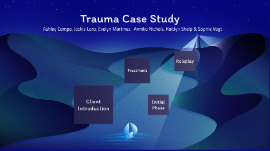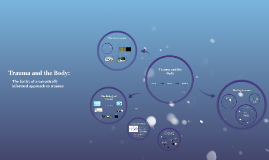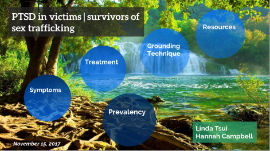Trauma Presentation
Transcript: November 15, 2017 Linda Tsui Hannah Campbell PTSD in victims | survivors of sex trafficking The recruitment, transportation, transfer, harboring or receipt of persons, by means of the threat or use of force or other forms of coercion, of abduction, of fraud, of deception, of the abuse of power or of a position of vulnerability, or of the giving or receiving of payments or bene ts to achieve the consent of a person having control over another person, for the purpose of exploitation (including, at a minimum, the exploitation of the prostitution of others or other forms of sexual exploitation, forced labor or services, slavery or practices similar to slavery, servitude or the removal of organs) What is sex trafficking? Prevalency - As defined in the UN Trafficking in Persons Protocol International Labour Organization estimates 27 million people become trafficked annually—4.5 million of whom are victims of forced sexual exploitation. The National Center for Missing and Exploited Children (2014) reported that 1 in 5 runaways are at risk for forced sexual exploitation. This represents an increase from an estimated 1 in 6 in 2014 Have been identified in all 50 U.S. states The FBI estimates sex trafficking in the U.S. involves 100,000 children, 60% of child sex trafficking victims recovered through FBI raids across the U.S. in 2013 were from foster care or group homes. Experts have extrapolated that the average age for girls entering the sex trade is 12 The average age of children involved in prostitution when recovered by law enforcement is 14. Stats 1 Control 2 Components of Control: (as conceptualized by Stacy Litam, 2017) Force: pertains to the physical restraint or serious physical harm that traffickers use to obtain and maintain control. Fraud: the use of false promises to lure persons into the human trafficking industry, is another method used by traffickers to control and exploit their victims Coercion : using threats of physical harm or physical restraint against a person Progression of power used by traffickers to control their victims and, in some cases, forge a trauma bond Grooming Process (as conceptualized by Stacy Litam, 2017) Stages of Grooming 3 Trauma bonding: form of coercive control in which traffickers instill a sense of fear as well as gratitude for being allowed to live Ensnaring Creating dependence Taking control Total dominance Homelessness and Sexual minority status: Runaway, homeless children/adolescents Foster Youth Location: areas of tourism Foreign Nationals Interpersonal and intrapersonal factors: Persons from any socioeconomic background, race or ethnicity may become trafficked History of past trauma or violence Social media and internet: Social media Web sites such as Myspace, Twitter and Facebook have been identified as a frequent tool used by traffickers to recruit adolescents Risk Factors Risk Factors 3 Symptoms Symptoms Posttraumatic stress disorder (PTSD) symptoms Depression Absence of emotional reactions Anxiety Self-blame, shame, embarrassed Helplessness, meaninglessness, powerlessness Nightmares Somatic Complaints / Physical Health Anger and rage control problem Suicidal ideas and attempts Paranoia, easily startled Stockholm syndrome Substance abuse Problems in everyday grooming Sleeping problems Dissociative disorders, feeling detached Psychosocial World 1 Effects of trauma from sexual exploitation and trafficking cause problematic constructs in the person’s psychosocial world: self-worth, life meaning, ability to trust others are all impacted, and can result in blaming of self, mistrust of authority figures, and a lack of supportive social or familial connections (Herman, 2003). Constructs in Psychosocial World Hard to trust Lack support system Shame Worthless Powerless Unpredictability 2 Hossain et al. (2010) posit that the consistent threat of harm to themselves and their family, the unpredictable nature, and a lack of control over their decisions regarding health, safety, and even the clients they see, leads to considerable trauma Unpredictability and Uncontrollability Severity 3 Complex PTSD or Disorder of Extreme Stress not Otherwise Specified Difficulties regulating emotions, including symptoms such as persistent sadness, suicidal thoughts, explosive anger, or inhibited anger; Variations in consciousness, such as forgetting traumatic events, reliving traumatic events, or having episodes of dissociation (during which one feels detached from one’s mental processes or body); Changes in self-perception, such as a sense of helplessness, shame, guilt, stigma, and a sense of being completely different than other human beings; Varied changes in the perception of the perpetrator, such as attributing total power to the perpetrator or becoming preoccupied with the relationship to the perpetrator, including a preoccupation with revenge; Alterations in relations with others, including isolation, distrust, or a repeated search for a rescuer; Loss of, or changes in, one’s system of

















